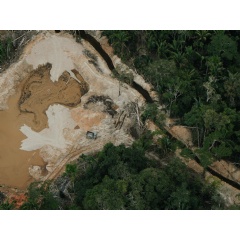Illegal gold mining has destroyed over 4,000 hectares of Amazon rainforest in just four Indigenous territories in the past two years, warns Greenpeace

Illegal gold mining remains rampant in the Amazon rainforest despite government efforts to curb it, reveals new analyses of satellite data from 2023 to 2024. According to the report by Greenpeace Brazil, national action to combat this destructive activity is not delivering a decrease, but rather a shift in the Indigenous territories affected.
While mining activities reduced in Yanomami, Munduruku and Kayapó land (down 7%, 57% and 31%), Sararé land saw a dramatic surge, with illegal mining up by 93%. In the past two years, the report finds, 4,219 hectares of rainforest have been destroyed by gold miners in these four Indigenous territories – an area equivalent to almost half the total area of Manhattan, or more than 5,900 soccer pitches.
Researchers also uncovered discrepancies in gold trade data. According to the investigation, Swiss imports exceeded Brazil’s reported exports by 67% in 2022 and 62% in 2023 – suggesting significant irregularities. Concerted action is needed to stem the trade in illegally mined gold, says Greenpeace.
Jorge Eduardo Dantas, Indigenous Peoples’ Campaign Lead from Greenpeace Brazil said: “As long as this gold is being bought by foreign countries, this remains a real threat to the Indigenous Peoples, the Amazon forest and the global climate. It’s driving deforestation, killing rivers and poisoning people and biodiversity. We need a sustained and integrated approach to fight illegal gold mining – from Brazil’s side and from the countries importing it.”
The report “Toxic Gold” by Greenpeace Brazil traces the path of illegal gold from the Amazon to global markets. As detailed in the report, in 2024, the top three destinations for Brazilian gold exports were Canada, Switzerland, and the United Kingdom – major international hubs for refining and trade.[1] Switzerland plays a particularly significant role, serving as the biggest international trading hub for gold and a gateway for over half of the EU’s gold imports, the report finds.
Global demand driving illegal mining is unlikely to slow. In 2024 alone, the price of gold rose by 44%, and many central banks are declaring their intent to stock up on gold reserves.[2]
Harald Gross, Amazon and gold campaigner from Greenpeace Germany said: “The world’s hunger for gold is destroying the vital Amazon rainforest – just to hoard gold bars that gather dust in bank vaults. This must change. International retailers have to disclose their supply chains and ensure that illegal gold stays out of the market.”
Illegal gold mining is a major driver of biodiversity loss and social tensions in Brazil, disproportionately affecting Indigenous communities and other vulnerable groups. Scientists have found that mercury used in extraction contaminates the forest and waterways, endangering wildlife and human health.[3]
Lula’s predecessor, far-right President Jair Bolsonaro deliberately weakened environmental controls in the Amazon. This triggered an explosion in exploration between 2018 and 2022, with a staggering 265% increase in illegal gold mining on Indigenous lands.[4] Since 2023, the current Brazilian government has intensified security and monitoring efforts in key areas. But Greenpeace Brazil’s research shows that illegal mining continues to adapt and spread across the forest – underscoring the urgent need for sustained, long-term strategies.
The Brazilian Supreme Federal Court recently ruled to close a legal loophole that had allowed buyers to accept gold without proving its origin, enabling illegal mining—often in Indigenous territories – to flourish unchecked. Gold buyers must now verify the legality of their purchases, and the government is required to enforce stricter oversight. The decision marks a crucial step in combating illegal mining. However, Greenpeace Brazil stresses that further action is needed to ensure lasting protection.
Photos are available in the Greenpeace Media Library.
The full report is available from Greenpeace Brazil: Toxic Gold
Notes:
[1] Table from Greenpeace Brazil’s Toxic Gold report shows the top Brazilian gold export destinations in 2024
Destination country - Trade value (USD) - Net weight
Canada $1.838.546.881 29.4
Switzerland $948.234.974 16
UK $579.388.660 7.5
UAE $211.441.948 3
USA $185.659.448 2.8
Germany $155.350.990 2.2
India $29.515.833 0.4
[2] Gold Demand Trends 2024 and Central Banks stock up on gold
[3] Report reveals widespread use of smuggled mercury in Amazon gold mining
[4] More than 90% of Brazil’s gold mining is concentrated in the Amazon
CORRECTION 8/04/2025: The 4,219 hectares of rainforest lost to gold mining in four Indigenous territories in just two years is equivalent in area to more than 5,900 soccer pitches. This higher figure replaces an earlier reference to ‘more than 4000’ in the second paragraph.
( Press Release Image: https://photos.webwire.com/prmedia/7/336749/336749-1.jpg )
WebWireID336749
This news content was configured by WebWire editorial staff. Linking is permitted.
News Release Distribution and Press Release Distribution Services Provided by WebWire.